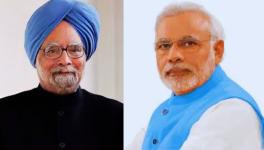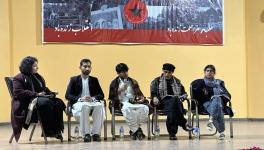Unaroo: Mani Ratnam’s Call to Malayali Youth to Wake up and Transform into Zombies Toiling for Capitalists
“Capital is dead labour, that, vampire-like, only lives by sucking living labour, and lives the more, the more labour it sucks.” – Karl Marx, Capital Vol. 1 Chapter 10
The last sequence in Mani Ratnam’s first and only Malayalam film, Unaroo (1984), shows Malayali youth uniting and breaking open the gates of a closed factory; not to expropriate it and take over its control but, in a twisted version of the rallying cry in The Communist Manifesto that calls for workers to unite, to gain the freedom to chain themselves to wage slavery.
Unaroo, which means ‘Wake Up’, was not written by Mani Ratnam (unlike most of his later films). However, even as the film is set in a poor fishing community and not the (largely upper-caste) middle-class surroundings that Mani Ratnam became famous for, it is filled with the tropes that we immediately associate with him – the young and rebellious protagonist making sense of the world, the child actors and older women, and conflicts and relationship issues. And so too, the middle-class outlook and sensibility of the director himself.
The opening montage sequence before the credits start rolling in Unaroo sets the tone for the rest of the film. Ramu (played by Mohanlal) arrives in Cochin looking for work, only to find out that no one will hire him without him joining a union. Very soon, we find out that the film holds trade unions responsible for any and every problem faced by the people – displacement, unemployment, corruption, violence, hoarding, black marketing and price rise.
Ramu is welcomed into the fishing community in Fort Kochi and becomes a member of the trade union started by the men there in order to fight for their rights and obtain jobs as dock workers that were promised to them when a port was built nearby. He channels his rebellious nature to fight for the community but eventually becomes disillusioned when he realises that the union may not be acting in the best interests of the people for whom he thought he was fighting for.
Janardhanan (played by Sukumaran) is the president of the union, who starts out with good intentions but transforms over the course of the film into the same conniving, smooth-talking (even scheming) politician like the rest of the union leaders in the film.
Unaroo attacks workers’ unions and puts them in the dock (literally and metaphorically) by erasing the very nature of labour and exploitation. Hence, for a film that purportedly shows the life of the working class, there are few shots of people working, even as there are multitudes of them protesting.
In fact, the shots that do show people labouring are often just prelude to them stopping their labour to protest. Managers here are docile men who easily agree to union demands and capitalists are intelligent ones who collude with the union leaders to enhance their wealth. Workers are both innocent idiots used by politicians for their own ends and selfish beings who do not act except in their own interests.
Violence, which the state holds monopoly over in reality, is instead shown as the exclusive domain of unions who attack capitalists, destroy public property or fight amongst themselves. The police are conspicuous only by their absence. The state and its police force are shown as incapable entities in front of the power wielded by unions. In short, the film seems to be saying that the unions are the ones in control, the ruling class, even without having any ownership of the means of production!
While the film positions itself as a critique of labour aristocracy (there are a couple of dialogues which work as exposition for this), it becomes evident that the real target is the organised working class movement. Workers in the film, who organise and strike for demands such as hike in pay according to the inflation index, end to threats from superior officers and administrators, releasing workers arrested for taking part in protests and making canteen facilities available in their workplace, are blamed for the lack of growth of existing industries and investment in new ones.
In another montage sequence towards the end of the film, set to mournful music by Ilayaraja, long shots of marching workers holding up red flags and shouting slogans are juxtaposed with those of deserted docks, unloaded cargo, empty pick-up trucks, abandoned cranes and closed factories.
The story arc pits these greedy workers against the unemployed youth who are frustrated that they are not able to get jobs – something which Baradwaj Rangan quotes Mani Ratnam referring to as “new blood looking for opportunities, and the older generation that wanted to continue in the same fashion”.
One of the unemployed youths asks the character that plays a minister in the film, “What is the need for you to rule the state if you cannot control them (the unions)? What is the need for the police and army?” Thus, it is not capitalism but the working class movement that the film depicts as the obstacle that stands between them and their liberation.
The neo-liberal state and the dominant ideology
It would be pertinent to note that Unaroo was shot and released not long after the 1975 Emergency, a period in which the attacks against the working class had no parallel in the history of independent India.
Through wage freeze, retrenchment, lockouts and summary dismissal of workers and repression through the use of police and paramilitary forces, mass arrests and hunt of trade union leaders; this period was the time when the organised working class movement in the country was brought to its knees, so that it was found limping when the neo-liberal offensive started.
It is also interesting that the trajectory which Mani Ratnam seems to have followed – from attacking the state for pandering to workers and going on to extoll market ideology and support a hyper-nationalist (even soft-hindutva) state – is the same trajectory that popular Malayalam cinema traversed in the 1980s and ’90s.
From a slew of movies in the ’80s that attacked working class organisation (some of them also written by T Damodaran, the scriptwriter of Unaroo) and spreading disillusionment with politics (culminating in the 1991 film Sandesam); Malayalam cinema harked back to a feudal culture and religious revivalism, along with unapologetic consumerism, in the ’90s that fitted nicely with the rise of both the neo-liberal state and of right-wing nationalism.
To demand that the state strip the workers of their rights at a time when labour was already at its weakest would necessarily involve a dominant ideology that favours the interests of capital over labour. To seduce workers into this dominant ideology requires that they have to be first hypnotised – transformed into the living dead, capable of working and breeding but not thinking. And what better way to do that than through a cultural commodity named Unaroo?
Get the latest reports & analysis with people's perspective on Protests, movements & deep analytical videos, discussions of the current affairs in your Telegram app. Subscribe to NewsClick's Telegram channel & get Real-Time updates on stories, as they get published on our website.
























